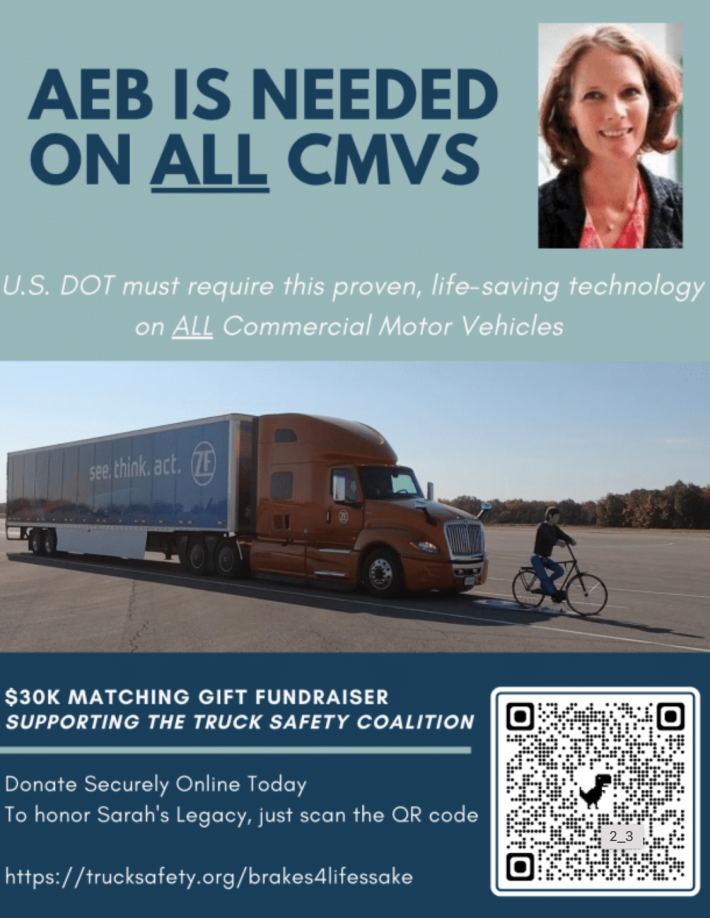U.S. regulators are considering a rule that could slash large truck deaths that are among the fast-growing segments of the national traffic violence crisis— or leave thousands of U.S. residents to die preventable deaths just to save fleet operators a few dollars.
According to the Office of Management and Budget, the National Highway Safety Administration is in the final days of a 90-day review process for a long-awaited and congressionally mandated new rule that would require automatic emergency braking on all new heavy-duty trucks sold in the U.S. over 26,000 pounds — and advocates hope, exceeding that requirement to include medium-duty vehicles over 10,000 pounds, while specifying that the systems be equipped to detect pedestrians and cyclists.
Since they became standard across European fleets a decade ago, automatic braking systems have proven to be a game-changing technology for the biggest vehicles on the road, reducing rear-end crashes by 41 percent for heavy-duty vehicles over 26,000 pounds, and 56 percent among medium duty trucks weighing in at 10,000 pounds or more. And considering those impacts represent 60 percent of all truck crashes, advocates say executing the mandate swiftly is nothing short of a moral imperative — and a cheap one to fulfill, since automatic emergency braking systems cost less than $300 per truck on average to install.
Under a provision in the 2021 Infrastructure Investment and Jobs Act, though, Congress gave NHTSA a two-year deadline to issue a rulemaking requiring the tech only on the biggest rigs on the road, stripping out language that would have required it on medium-duty trucks — the fastest growing segment of the market by far — and failing to explicitly require vulnerable-road user detection. NHTSA is free to exceed that low bar, but some worry they won't.
"This rule’s been a long time coming, and it is quite the game changer," said Zach Cahalan, executive director of the Truck Safety Coalition. "What everyone's waiting on pins and needles for is to find out, 'Will NHTSA do more?' ... Because if they do, this could be really legacy-defining work."
With large truck death rates exploding on U.S. roads, Cahalan says that new rule can't come soon enough.
Even with buses and motor homes excluded, fatalities involving vehicles over 10,000 pounds skyrocketed a stunning 71 percent between between 2009 and 2021 — nearly three times faster than car crash deaths overall, which rose an already-horrifying 27 percent over the same period.

The reasons behind that discrepancy haven't been thoroughly studied, but some hypothesize that rise of e-commerce and its swarms of medium-format delivery vans is a factor, as well as lax hours-of-service regulations that have made drowsy driving more commonplace among commercial drivers, poorly-maintained vehicles, and even loopholes in licensing laws that allow over-the-road truckers who lose their licenses in one state to keep driving in others.
Cahalan also points out that medium-duty vehicle sales have experienced a particularly large explosion in growth in the last two decades, and that many are being driven by people without special training on how to operate them — which makes it all the more baffling why the Senate stripped those vehicles from the proposed automatic emergency braking requirement after a House bill initially included them.
"If you’ve ever rented a U-Haul, you’re well aware that you do not need a commercial driver's license to drive most medium-duty trucks," he added. "In a lot of these situations, you have folks without specialized training who are driving pretty large-sized commercial vehicles, and they're not familiar with their handling needs, braking distance, or how they operate in wet conditions. Arguably, you can make a case that these folks need AEB more than anyone else ... To exclude medium-duty at this time is a big miss."
Cahalan rejects arguments from the trucking industry that automatic emergency braking systems are too expensive to install, especially considering that they could easily save money compared to crashes themselves — which he says cost society at large $166 billion in 2020 alone, adjusted for inflation — and the fact that the price of the tech is likely to come down once it reaches an economy of scale. He also rejects the common industry argument that automatic braking is too unreliable — especially when compared with human drivers.
"Especially as the tech continues to mature, even the occasional false activation is far preferable to the alternative — which is not being able to prevent roughly half of all crashes," he adds.
Cahalan says the best argument for a strong automatic emergency braking mandate, though, is what it will cost American families not to have one — because too many have already paid that price.
"I can’t tell you how many times someone’s story begins with, 'I was stalled traffic, and this truck just didn’t slow down,'" he said. "And its ends with, 'It rammed into my husband’s car, my kid’s car' — insert the name of a loved one who was taken. This is about more than the numbers. Many people would still have their most beloved people by their sides right now had this tech been available before."






